文科写作类竞赛作为背景提升的重要一环,近些年来也愈发受到留学生们的青睐。
除了John Locke这种耳熟能详的天花板级写作比赛之外,哈佛国际评论学术写作竞赛也是一个适合想要锻炼思辨能力、培养全球视野的比赛!
距离HIR夏季赛论文提交
还有不到15天
!!!
同学们论文进度如何了?
《哈佛国际评论》学术写作挑战
《哈佛国际评论》学术写作挑战是面向全球中学生的英语写作类活动,旨在鼓励青年学生以写作的方式表达对共建人类命运共同体及国际事务的关注与思考。
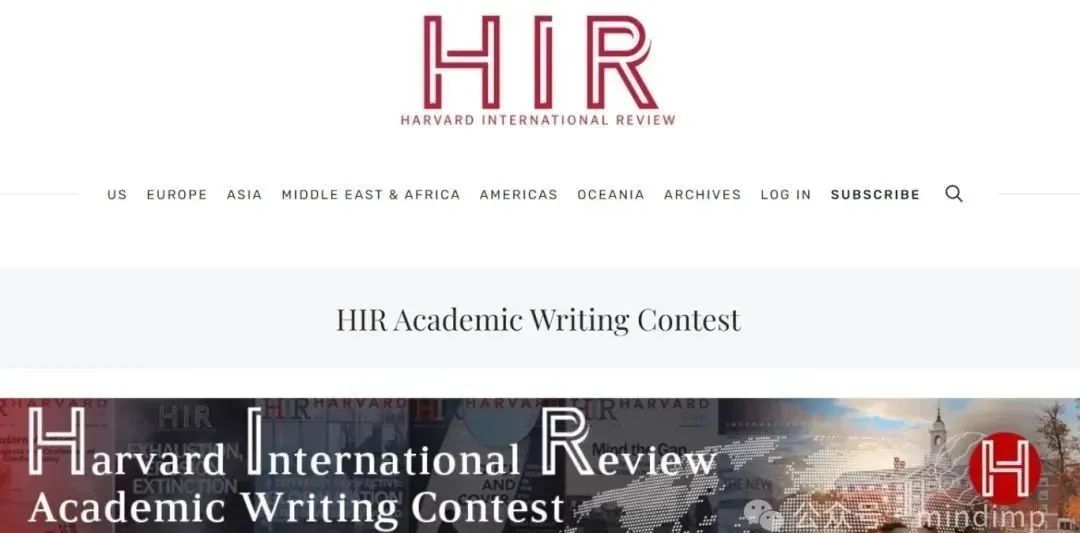
适合学生
全球9-12年级高中生
赛事时间
竞赛分为春季、夏季、秋季/冬季三个不同的提交周期。
☑ 2024年春季赛:
提交截止日期:5月31日
答辩日:6月29日
☑ 2024年夏季赛:
提交截止日期:8月31日
答辩日:10月5日
☑ 2024年秋/冬季赛:
提交截止日期:25年1月2日
答辩日:25年2月5日
命题领域
HIR作为一个自命题学术论文,主题不需要出现在文章题目或内容中,只要选题角度和写作内容能够反映竞赛主题理念即可。
命题方向包含但不局限于:农业、商业、网络安全、国防、教育、就业&移民、能源&环境、金融&经济、公共卫生、科技、太空、贸易、交通运输等领域。
写作要求
字数:800-1200(不包括图表、数据表或作者声明)
需标注对书籍和文献的引用,符合引用规范,清晰体现出基于研究得出的观点和见解。
比赛流程
• 先注册并付款后才可提交作品
• HAWC的参赛费用为1480元/队(可单人或组队参加,每队不超过两人),费用包括赛事注册费、评审费、配套课程、线上答辩、HIR期刊订阅、证书制作、提名认证服务
• 哈佛国际评论的主编们对作品评分
• 如果被选为决赛选手,学生将被邀请参加HIR决赛答辩。在HIR答辩日,学生将向哈佛国际评论评委进行15分钟的演讲和口头答辩
• HIR竞赛官网:
https://hir.harvard.edu/contest/
奖项设置
☛ 所有提交的作品都将获得哈佛国际评论的字母等级评定。
☛ 在没有资格参加HIR决赛答辩的情况下获得及格分数的参赛者将获得表彰奖。
☛ 根据他们在HIR决赛答辩的初步成绩和表现,决赛入围者将有资格获得以下奖牌:
🏆HIR 嘉奖获奖证书(获奖率约 40%)
🏆铜奖:HIR 铜奖获奖证书、网站上提名
🏆银奖:HIR 银奖获奖证书、网站上提名
🏆金奖:HIR 金奖获奖证书、获奖作品及参赛者姓名公布于官网
比赛详情可扫码咨询
👇👇👇

扫描上方二维码,可咨询顾问更多信息
HIR推荐理由
1.TOP大学背景加持
背靠世界顶级学府哈佛大学,该国际专业赛事汇聚了众多顶尖学者、资深编辑及才华横溢的学生作为投稿者,确保了赛事的权威性。
入围决赛的选手将享有与评审团进行个性化深入对话的宝贵机会,这不仅是一次思想的碰撞,更将成为未来申请美国顶尖本科课程时的一大亮点与助力。
2.选题自由度高,文理科“通吃”
哈佛国际评论写作大赛倡导学生跨越学科界限,自由探索从农业、商业到网络安全,再到国防、教育、就业与移民、能源与环境、金融与经济、公共健康、科学与技术、太空、贸易及交通等广泛议题,搜集素材并撰写文章。
确保了无论学生背景是文科还是理科,都能在其擅长的领域内发挥所长。
3.有利于提高综合学术能力
参与学术写作竞赛,学生需历经选题构思、独立深入探究及精细文字雕琢等多元学术挑战,此过程不仅锤炼了他们的综合学术素养,还为他们提供了丰富的学术实践经历,使他们能够预先领略并适应本科层次学术任务的多样性与高标准。
HIR推荐阅读
为了给同学们提供更多写作灵感,我们从HIR官网选取了一些不同领域的范文,给大家进行参考,可以从中学习好的方法论~
01、The Future of the Sino-Venezuelan Relationship: Make or Break?
Finance & Economics
Law & Diplomacy
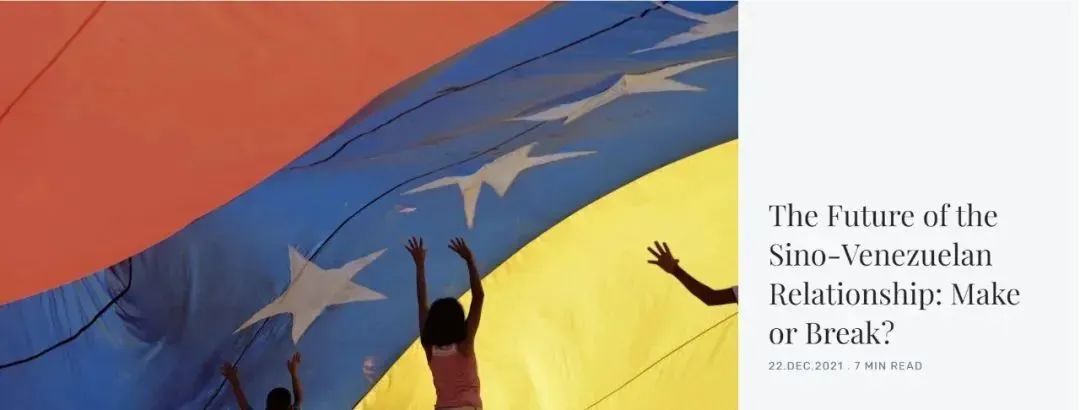
With the largest oil reserves in the world, Venezuela is a country that has undergone many changes since the 20th century. The nation went from being the wealthiest per capita country in South America during the OPEC oil embargo of 1973 to having a hyperinflation rate close to 10 million percent in 2019. Venezuela’s modern history revolves around their oil industry, dating back to the discovery of rich reserves in 1922. In just seven years, the country was producing 137 million barrels per year. At the time, it made them the second largest oil producer in the world.
Such large growth does not go unnoticed by global superpowers. Major nations have become involved in Venezuela as a result. One of these countries is China, the world's largest importer of oil. Venezuela's relationship with China grew with President Hugo Chavez’s rise to power in 1998. Throughout his presidency, the two countries worked together to establish mutually beneficial projects that helped the Latin American country in exchange for its abundant natural resources.
These projects have required a large amount of capital. Since 2007, China has invested around US$67 billion into Venezuela. Compared to the rest of Latin America, this is more than 40 percent of Chinese investment in the continent.
Graph displaying Chinese foreign investment in South America. “Top 5 Chinese Loan Recipients in Latin America and the Caribbean” by IAD China-Latin America Finance Database.
Apart from its oil supply, China saw Venezuela as an open market for engineering projects and arms deals. During the inception of the current Sino-Venezuelan relationship, Chinese companies would compete for large infrastructure projects, such as Latin America’s first high-speed railway. Most of these projects ceased with the downfall of the Venezuelan economy. However, China is still Venezuela’s second largest seller of arms.
Its location also makes it a prime spot for exerting influence over the continent. Its proximity to the United States means that China’s involvement symbolizes a concern for the North American superpower, which has historically sought to establish itself as a dominating foreign influence in Latin America through its many interventions during the Cold War years.
Although the relationship between China and Venezuela seemed to work successfully, many things changed with the death of President Chavez in 2013 and the collapse of oil prices in 2016. During this time, the country’s total output of oil decreased by 25 percent. The World Bank has placed Venezuela’s government effectiveness in the 2.4 percentile of countries while its corruption percentile is 3.85. Currently, 96 percent of the Venezuelan population lives under the poverty line. The high hopes China had for the Latin American country fell with the collapse of Venezuela’s economy. Recent studies predict that the country still owes China around US$20 billion.
Given the large risks that China is currently facing with Venezuela, different entities question China’s future plans with the country. There are different theories for why the Asian giant is still so heavily involved in the Latin American nation.
Shared Political Ideology
During Chavez’s presidency, many were quick to question if the new alliance between the two countries were based on shared political ideologies. Both governments have greatly authoritarian views that differ from most American countries. China claims that the partnership “did not have an ideological purpose, and was not designed to confront third parties nor to affect Venezuela's relations with any other country.” Meanwhile, Chavez would emphasize that Venezuela’s political relations with foreign nations were based on their negative relations with the United States. If it is the case that the relationship between the two countries is based on their political ideas, it would seem important for China to protect Venezuela from a collapse.
Future Plans with Venezuela
Another possible driver is China’s future geopolitical plans within the nation and the continent. When relationships with the Latin American country first began, China was still establishing its presence in the developing world. Venezuela was the start of China’s investments in the region, which grew from US$12 billion in 2000 to US$300 billion in 2019. Venezuela also supported China through various multilateral organizations. There has been a large exchange of services between the two countries, ranging from military training to communication satellites.
The dynamics of the relationship has changed since the early 2000s. Under authoritarian President Nicolas Maduro, the Venezuelan government is now seen by many countries as corrupt and inefficient. China’s alliance with the nation is hurting the reputation that it has strived to develop. China still plans to be a leader in the South American economy, given its large investment plans in the region. If China is to continue its relationship with Venezuela, they will have to do so without directly supporting the regime itself. This lack of support must be made public, which could have detrimental effects on the current contracts with Venezuela and the relationship between China and its allies. Due to these externalities, it seems unlikely that the Asian country will take such action. However, this approach could bring support from most Latin American countries in which China has investments, given that most of Latin America supports President Juan Guaido and the democratic resistance. Even with the current change in the relationship, state-owned Petroleos de Venezuela still has China as its second largest customer.
Stakes are Too High to Leave
There is reason to believe that China feels it is too involved with Venezuela. With its large outstanding loan, China could be focused more on getting its payments back than strengthening its diplomatic relations. When economic models for Venezuela changed in 2016, China cut off all its lines of credit with the nation. Venezuela’s drop in oil production and the drop in oil prices also make it harder for China to trust Venezuela with its payment. In response to the changing economic state of the Latin American country, the Asian giant has revealed existing communication channels with Venezuela’s opposition party to ensure debt payments. Ultimately, China has to decide if Venezuela’s debt is more valuable to them than their shared political philosophy.
Venezuelan crude oil production by year and World price of crude oil per year. “Venezuela: From Oil Boom to Bust” by the Federal Reserve Bank of St. Louis; U.S. Energy Information Administration.
Steps Forward
Despite China’s current goals in Venezuela, the Asian nation remains in a suboptimal position. While they have a strong incentive to help rebuild Venezuela’s economy in the form of repayments, doing so would not be a simple task. China would have to invest even more of its capital into the nation while also ensuring that corruption does not deplete the value of Chinese investments. Some estimates state that an investment of US$150 billion over the next 10 years will be necessary to get Venezuela back to past levels of oil production . Most of the capital will have to come from foreign investments. If China wants to ensure their payments, they would have to further help the Latin American country. This kind of initiative would increase tensions with the US, given the direct opposition that the US maintains to the current Venezuelan regime.
China could also aid the opposition in Venezuela if they promise to repay its loans. This carries precautions on its own, given that Chinese allies like Russia and Cuba have a substantial incentive to stay active in the region. These incentives come in the form of military deals with Venezuela. These countries would also not be able to be as involved in the region as they currently are if a new government takes over. If China were to support the opposition, it would negatively affect its relationship with current allies.
There would be great ideological tensions within China itself if it supported the democratic opposition, given the communist and authoritarian philosophy of its own government. Supporting a democratic government would be seen as largely hypocritical by the rest of the world. Even though China’s administration is greatly different from that of Venezuela, the shared basis in which their governments stand leaves China almost unable to support a democratic administration. If China were to support the Venezuelan resistance, it would not look good for the Asian country and what it stands for. China could try to make it clear that their sole interest is the debt, although they would have to do so very carefully.
China could also forgive its loan with Venezuela and move on with its geopolitical strategies. This approach would prevent further rising tensions with the US coming from involvement the South American country. The downside is the precedent that it sets. China is involved in risky investments with developing countries through their Belt and Road Initiative. If it allows one of its investments to default, it would make it easier for another country to do the same. This has the potential to disrupt their initiative, given that not all developing economies are able to pay their loans. This is part of the reason why investments in these regions are seen as high-risk. If China’s investments begin to default, the country will lose capital and its reputational power as leading the developing world. The Asian giant will have to decide if helping Venezuela is worth the potential sacrifice that it may bring to their political agenda.
Regardless of China’s decision, there will be consequences that will impact countries both directly and indirectly. It is important for the Asian giant to think of how they want the world to see them and what relationships they value most. Given its larger global strategies, China will also need to assess what it is willing to sacrifice in order to become the most influential power in the developing world.
链接:https://hir.harvard.edu/the-future-of-the-sino-venezuelan-relationship-make-or-break/
02、Running Dry: The Battle for Water Security in Uruguay and Why It Foreshadows a Greater Issue
Energy & Environment
Development
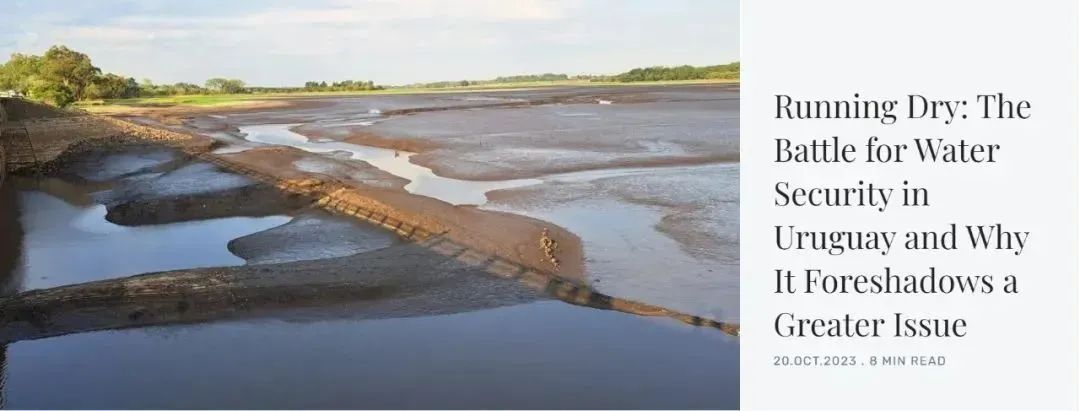
On June 22, Uruguay’s Archbishop, Daniel Sturla,tweeted: “Our God, we ask You to give us the necessary rain.” He was responding to the water crisis the South American nation has faced for the past three years, the worst in over half a century. While some thanked the Archbishop for his efforts, others pointed out that God is probably not very active on Twitter.
Home to just over 3.5 million people—less than the Greater Boston Area—Uruguay has beenovershadowedby neighboring giants Argentina and Brazil for most of its history. However, itboastsone of the highest human development indices and GDP per capita in the region. In 2004, Uruguay also became the first country in the world torecognizeaccess to drinking water as a constitutional right, a pledge it is currently struggling to uphold.
Since 2020, Uruguay hassuffereda series of droughts that have led to billions in losses in the agricultural sector, the country’s biggest industry. Most alarmingly, the droughts havethreatenedaccess to safe drinking water for the capital of Montevideo’s Metropolitan Area, where 60 percent of the population—approximately 1.9 million people—live. Montevideo’s main water source, the Paso Severino Reservoir, currently holds nine percent of its normal capacity, a figure thatreachedan all-time low of 1.7 percent in early July. This droppromptedthe Uruguayan government, led by center-right president Luis Lacalle Pou, to declare a water emergency on June 19.
Step 1: Add 440mg of Salt
In order to meet demand, the State Sanitary Works Administration (OSE), the body in charge of the country’s water supply,decidedto gather water from sources closer to the River Plate. This solution, however,poseda new problem. The river’s proximity to the Atlantic causes it to have greater salinity, which spread to the entire network. The World Health Organizationrecommendsthat sodium levels in drinking water not go above 200 mg/L; in Montevideo, current valuesaretwice that.
“Of course, lack of water is worse, but drinking saltwater for a prolonged period can have devastating cardiovascular consequences,”saidcardiologist Álvaro Niggemeyer. The Health Ministryinformedthe public that, while the water is technically potable, pregnant women, infants, and people suffering from cardiovascular and other health issues should minimize their tap water intake and take additional precautions.
The rest of the population quickly followed suit. A poll from Junefoundthat six percent of Uruguayans continue to drink tap water, compared to over 66 percent last year. Conversely, bottled water sales haveskyrocketedby 573 percent from 2022. Retailers were forced to implement purchase quantity restrictions, but scarcity prevails—in large part due to hoarding levels not seen since the beginning of the COVID-19 pandemic. “We receive over 200 bottles a day, and they don’t even last two hours on shelves,” one grocery store managersaid. Suppliers nationwide have been working at maximum capacity, and the government isconsideringremoving taxes from imported bottled water.
“We’re in a complex situation, one which unfortunately requires us to wait for it to rain. But rest assured that anything we can do to ease the crisis we will do,”saidPresident Lacalle Pou.
It Wasn’t Always Like This
Having clean and abundant water has become ingrained in Uruguay’s national identity. Children are taught early about the countryhavingone of the largest renewable water reserves per capita—five times the world average—and how Uruguay is (or was) the only South American nation with universal access to safe drinking water.
In normal years, Uruguayreceivesapproximately 1300mm of rain, a valuecurrentlyat 300mm. Montevideo was one of the first capital cities in Latin America toinstallpiped water systems, yet it is now scrambling to find water to pump—butwhy?
A Historic Dry Spell
For three and a half years, Uruguay has faced itsworst droughtin 74 years, caused by the weather phenomenon ofLa Niña–which cools the Pacific Ocean’s surface and leads to dry periods–and further aggravated by increased temperatures.
Rainfall in Uruguay usuallyresultsfrom the movement of cold fronts in winter (June to August) and regular thunderstorms during summer (December to February). This year, however pleasant to beachgoers, the latter never came, with certain regionsexperiencingthe hottest temperatures in over 40 years.
Many were quick to point the finger at climate change, which exacerbated the issue but was not the sole culprit. The World Weather Attribution, a group of independent scientists studying the impacts of climate change on extreme weather events,concludedin a February report that “reduced rainfall is within the natural variability,” but the “consequences of drought are becoming more severe due to the strong increase in extreme heat.” In any given year,La Niñahas a five percent chance of developing, yet 2023 marks the third consecutive period it has formed—an anomaly which expertsagreeis in large part due to global warming. Therefore, although the dry spell falls within expected climatic variations, extreme weather conditions have enabled it to have more drastic effects. In addition to Uruguay, neighboringArgentinaandBrazilhave been facing similar issues.
The situation ispredictedto improve in the spring (September to December) once theEl Niñophenomenon reaches the region, which, opposite toLa Niña, brings high levels of precipitation. However, some are skeptical that it will not be enough. “We’re relying on rain as the only answer, but completely neglecting the political and cultural change needed about how we view water,”saidgeographer Marcel Achkar.
Historical Mismanagement of Environmental Resources and Normalcy Bias
Never has Uruguay faced a water crisis of this magnitude, undermining a popular misconception that water resources were virtually inexhaustible. “We tend to think nothing could ever happen here,”jokedDaniel Panario, Director of the Ecology Institute within the University of the Republic. In many ways, Uruguay won the geographic lottery: well-defined, temperate seasons; arable lands; and minimal propensity to natural disasters. But the current crisis highlights the flaws in Uruguay’s management of environmental resources.
The aforementioned constitutional reform in 2004 was a landmark decision inensuringequitable access to water, but many have said the Uruguayan government has since dropped the ball. This decision established the basis for public water resource management, emphasizing social participation and sustainability. While it is praised for enabling the country to achieve almost universalaccessto water, subsequent utilization suggests that the pledged focus on human consumption has not been fully realized.
Carmen Sosa, a member of the National Commission in Defense of Water and Life—which led the fight for reform in 2004—saidin an interview that “our water resources have been looted by agribusiness and multinationals.” She continued: “The rice industry consumes four times more water than the population, wood pulp 10 times more, soybeans 17 times more, and livestock 20 times more.” The top 19 most water-demanding companiesconsumemore than the entire population, the latter comprising only five percent of the overall usage. Finnish cellulose giant UPM alone, which has operations in the country’s North,consumesmore water than half of the Uruguayan population combined.
These businesses extract water from the same sources as the general public but are not bound by the same rules. As a consequence of the crisis, OSEimposedfines on excessive water consumption for individuals, yet no restrictions were implemented for the industrial sector. Researchers havewarnedfor years that this business model was unsustainable, but resources continued to be depleted despite what was pledged in 2004.
Poor planning and constant postponement of infrastructure projects are also to blame. The last major reform to Uruguay’s water network was in 1987 with theinaugurationof the Paso Severino reservoir. Since then, projects were proposed—and quickly left behind—by administrations across the political spectrum. Most notably, former president José Mujicainitiatedthe Casupá Project back in 2013, which would have been able to fulfill 70 percent of Montevideo’s demand; however, 10 years and three administrations later, it is nothing but an idea. “We all fell asleep,”admittedMujica.
Severe underfunding of OSE has also undermined efforts to maintain existing infrastructure, particularly pipes. OSE’s investmentbudgetin relation to GDP was 0.1 percent in 2022—a value that has seen a downward trend since the early 2000s. It isestimatedthat50 percent of water is lostin the distribution process because of leakages, but insufficient funds and attempts to reduce OSE’s workforce have slowed efforts to fix them.
The current situation broke thenormalcy bias(the idea that because something did not happen in the past, it will not happen in the future) mentality that much of the population—and the government—employed to justify the misuse of resources and downplay the severity of the crisis. Preventive investments and cultural changes are necessary to prevent these sorts of disasters from increasing in frequency and magnitude. However, many politicians have deferred such actions because the benefits are seen far later than their political mandates end, proven by Lacalle Pou’s middle-to-short-term solutions for the long-term crisis.
Thirsting for Solutions
Lacalle Pou’s administration waspraisedinternationally and domestically for its swift and humane approach to the COVID-19 pandemic, yet many Uruguayans question Pou’s strategy regarding the water crisis. “We acted thinking that it was a temporary matter and that the rains were going to come,"acknowledgedVice Minister of the Environment Gerardo Amarilla. About 63 percent of Uruguayansdisapproveof the administration’s drought management, a recent poll found.
In the short term, the government has addressed the issue of the growing demand for bottled water. Parliament recentlyapproveda temporary tax relief on bottled products, which would make them 30 percentcheaper, and begandistributingtwo liters of water a day to more than 500,000 citizens of the Montevideo Metropolitan Area living in low-income households. Both efforts combined aresetto cost US$22 million and will last a month unless extended by Parliament.
Middle-to-long-term solutions have fallen victim to political discourse. Lacalle Pou’s right-wing coalition proposed a new initiative, theNeptune Project, which would create a privately-owned potabilization plant on the River Plate that would beloanedto OSE for US$40 million annually. The left-wing Broad Front opposes the move and defends going forward with the Casupá Reservoir instead. A spokesperson for the partysaidNeptune would be “a highly inconvenient privately managed project, with an enormous cost that will defund OSE.” The Head of Stateclarifiedthe Casupá Project “was not discarded.”
As the debate continues, finding a sustainable approach to tackle the water crisis remains a pressing task for the Uruguayan government, especially given growing concerns from social and international groups.
“It’s Not Drought, It’s Pillage”
Activists took to the streets on May 31 to protest the crisis’ mismanagement. Their slogan can still beseenacross Montevideo’s walls:It’s not drought, it’s pillage. “We just want the government to respect our Constitution, to keep businesses like Google under control,” a demonstrator explained. Theyalludedto the search giant’s recently announced plans to open a data center in Uruguay, whichsparked outrageafter sources estimated it would consume two million gallons of water daily—equivalent to the daily consumption of 55,000 people combined.
The international community shares these concerns. A recent UN reportfeared“risk of de facto water privatisation” and condemned the prioritization of industrial usage. “Uruguay must put human consumption at the forefront, as indicated by international human rights standards," the report said. In response, the Uruguayan governmentissueda statement highlighting the report's “inaccuracies.”
Looking Forward
If anything beneficial comes out of this crisis, it should be a wake-up call to Uruguayans that water is not infinite, that natural resources must be used and regulated responsibly by everyone, from individuals to Big Agro.Deemedthe most democratic nation in the Americas by The Economist, Uruguay must once again grant people equitable access to drinking water, a recognized constitutional right since 2004.
Uruguay’s present may be the future for several nations. They should look at Montevideo’s crisis and learn from its successes—and its failures.
The cover photo, titled "Represa de Canelon Grande seca durante la sequia," was taken by Enxuta and is licensed under CC BY-SA 4.0.
链接:https://hir.harvard.edu/running-dry-the-battle-for-water-security-in-uruguay-and-why-it-foreshadows-a-greater-issue/
03、Public Health and Overpopulation: The United Nations Takes Action
Public Health
Anniversary
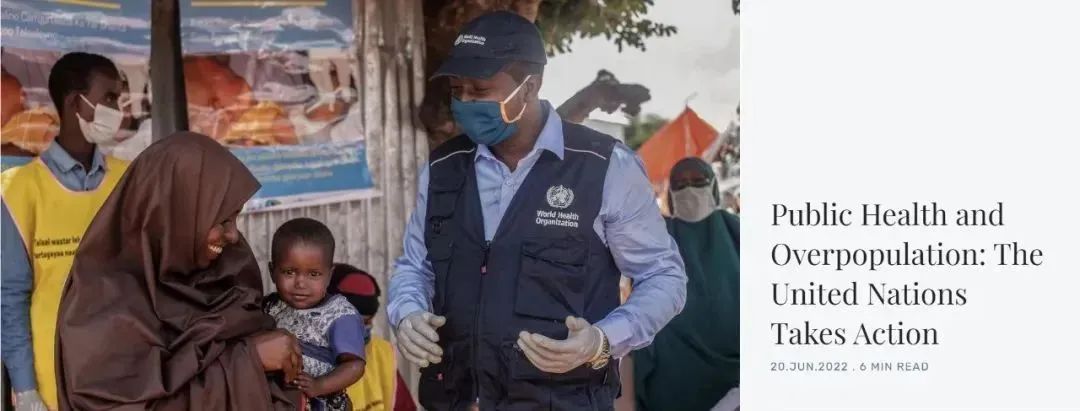
With the world’s population rising faster than ever before, will our population growth outpace our resource reserves? How can the dangerous effects of overpopulation be managed without diminishing the major improvements in our quality of life that come about thanks to population growth?
The UNprojectsthat over half of the Earth’s population growth in the next three decades will occur in the continent of Africa. This is due to the fact that, from 2010 to 2015, Africa’s population grew at a rate of 2.55 percent annually, with the continent still maintaining thehighestpace of population growth among other continents. The UN predicts that, behind Africa, Asia will be the second greatest donor to future international population growth, with an expected addition of approximately one billion people by 2050. In contrast, within every European nation, fertility rates are currentlybelowthe population replacement level, which is approximately two children per woman. In most of Europe, fertility rates have remained beneath replacement level for decades. The global population grew fourfold in the past 100 years, so what impact could increased population growth have in the future? Will there be mass-migration? Overcrowding in already densely populated or resource-rich areas? Poor living conditions and sanitation similar to Industrial Revolution era slums?
The global population is currentlyrisingat a steady rate. The number of humans existing on Earth has never been as high as it is now. In 1800, Earth had approximately 1 billion inhabitants, which rose to 2.3 billion in 1940, then 3.7 billion in 1970, and approximately 7.5 billion today. In the last five decades, Earth hasexperiencedan extreme population boom. This phenomenon is known as overpopulation, where the condition in which the amount of humans currently existing on Earth outstrips future resource availability and earth’s carrying capacity. Throughout human history, birth and death rates have always counterbalanced each other, which ensured that Earth had a maintainable population growth level. However, in the 1960s, the global population increased at an unparalleled rate. This brought about a variety of apocalyptic predictions, most prominently, a revival of the Malthusian trap panic.
Paul R. Ehrlich’s 1968 novel,The Population Bomb, eerilyechoesThomas R. Malthus’s landmark 1798Essay on the Principle of Population. Ehrlich’s novel proposes theories regarding potential outcomes for when agricultural growth does not keep pace with population growth. Ultimately his theories say that the world’s food supply will inevitably become inadequate for feeding the general population, whose numbers would continue to swell until famine, disease epidemics, war, or other calamities took root. These Malthusian predictions about out-of-control population growth have resulted in a variety of detrimental global impacts, particularly the emergence of extreme reproductive control measures, which have taken center stage on an international scale. Today, despite the fact that population scientists mostly agree that Malthus’s forecasts were overblown, the lingering prevalence of these fears have contributed to millions of forced sterilizations in Mexico, Bolivia, Peru, Indonesia, Bangladesh and India, as well as China’s two-childpolicy. Overall, this has left many wondering whether extreme population growth projections are legitimate or merely groundless panic perpetuated by alarmists.
The Demographic Transition
In reality, rising birth rates and population booms are components of a four-step processcalledthe demographic transition, which the Earth is currently undergoing. Most developed nations havealready madethis transition, but other countries are currently experiencing this change. In the 1700s, the entire world was undergoing the first stage of the demographic transition. During this time, the continent of Europewas ineven poorer condition than the modern-day definition of a developing region, and was afflicted with inferior public health, sustenance, and medical facilities. Birth rates were higher; however, death rates were also higher. For this reason, population growth remained largely stagnant.
Statistically, in the 1700s, womenbirthedfour to six children. However, on average, only two survived to adulthood. When the Industrial Revolution began in Great Britain in the mid-18th century, the Earth experienced the most significant shift in human lifestyles since the Agricultural Revolution. The Industrial Revolution altered every aspect of society, and fostered a greater sense of global interconnectedness. For example, many peasantsbecamefactory workers, manufactured productsbecamewidely available due to mass production, and countless scientific advancements improved existing methods of transportation, communication, and medicine.
Gradually, this economic developmentcreateda middle class and, after the work of union activists, ultimately raised the standard of living and health care for the impoverished labor demographic. Thus began the second transition stage. The increased availability of better foodstuffs, sanitation, and medicine directly contributed to lower death rates, causing a population explosion that doubled Great Britain’s population from 1750 to 1850. In the past, families tended to have more children because not all were expected to survive, but when child mortality rates decreased, the third transition stage was launched. This stage involves reduced conception rates and slowing population growth. Ultimately, a balance was established, with fewer deaths and births, creating a stable population growth rate and signifying the attainment of the fourth and final stage of the demographic transition.
Even as birth rates havedecreaseddramatically, Earth’s population is still rising at an alarming rate because the humans conceived during the population boom of the 1970s and 1980s are currently having more children; however, the current average number of children per family remains two and a half, while it was five during the late 1970s. As this generation ages and its fertility diminishes, the rate of population growth will likely continue to decrease in every nation. Most of the world’s countries have reached the fourth stage of the demographic transition. In approximately 80 years, developed countries will experience a reduction in fertility from over six children to fewer than three children. Malaysia and South Africa reached this point in 34 years, Bangladesh in 20 years, and Iran in 10 years. If developing countries are afforded more support, they will reach this point much faster.
Overall, most scientistspostulatethat human population growth will eventually come to an end, and the UN predicts that Earth’s population will not exceed twelve billion. Some of the major causes of population growtharereduced infant mortality rates, increased lifespans, higher fertility rates, advances in science and technology, and improved access to proper medical care. With the UN’s continued assistance, concurrent with overpopulation, the development level of the global community will increase, and the number of people living in poverty will decrease. Nonetheless, an ever-expanding human population is an immense social and economic challenge that necessitates the alignment of different national interests, especially with regards to reproductive rights, resource availability, and environmental concerns.
The United Nations Takes Action
In 1969, the United Nations Population Fund (UNFPA) wasestablishedin order to lead the UN in implementing population programs fundamentally based on the notion of family planning, or the “human right of individuals and couples to freely determine the size of their families” without governmental interference or legislation. In 1994, at the International Conference on Population and Development in Cairo, Egypt, the designated objectives of the UNFPA were determined in greater depth. It was decided that the UNFPA would specifically focus on the gender and human rights elements of population issues; consequently, the UN Population Fund was granted the lead role in aiding nations in fulfilling the Conference’s Programme of Action.
The three most significant sections of the UN Population Fundmandateare “Reproductive Health,” “Gender Equality,” and “Population and Development.” The United Nations Population Division (UNPD) works toconfrontthe interconnected global issues posed by population growth, which is primarily fueled by rising fertility rates, increased longevity, and greater international migration. The UN produces the official demographic approximations and predictions for every country and all regions of the world. The UNFPA specificallyaddressesglobal population by compiling data and statistics regarding migration, fertility, marriage, regional development, urbanization, world population projections, and national population policies.
In November 2012, the UNFPAdeclaredfamily planning a global human right; however, approximately 12 percent of 15 to 49-year-old women internationally are not afforded access to family planning. This is considered an egregious modern-day human rights infringement. The UNFPA aids various UN bodies like the Commission on Population and Development, and endorses the implementation of the Programme of Action undertaken by the International Conference on Population and Development (IPCD) in 1994. The UNFPA has been successful in urging international cooperation on the issue of securing family planning as a human right,pushingthe UN toholdthree conferences concerning the issue of population, along with two special sessions of the General Assembly and asummit in 2019.
The Way Forward
Ultimately, apocalyptic population growth fears are overblown, and as such, draconian population control regulations are unnecessary. We have witnessed progress on an international scale in this area, perhaps most notably with Chinarevokingits infamous, longstanding one-child policy just seven years ago. However, a broader global focus on guaranteeing family planning as a human right remains essential. In the words of economist Julian Simon, “Whatever the rate of population growth is, historically it has been that thefood supply increasesat least as fast, if not faster.” Since Ehrlich’s initialfear-mongeringregarding an overpopulation-induced Armageddon, the planet’s population has more thandoubled. However, annually, famine deaths havedroppedby millions. Today’s famines are war-induced, not caused by natural resource consumption. As production rose,prices fellandcalorie consumptionincreased, which decreased malnutrition worldwide. In Simon’s words, human ingenuity is the “ultimate resource.” Therefore, the enactment of heavy-handed population-control regulations is not only abhorrent, but is also irrational and unsupported by scientific evidence.
链接:https://hir.harvard.edu/public-health-and-overpopulation/
本期福利
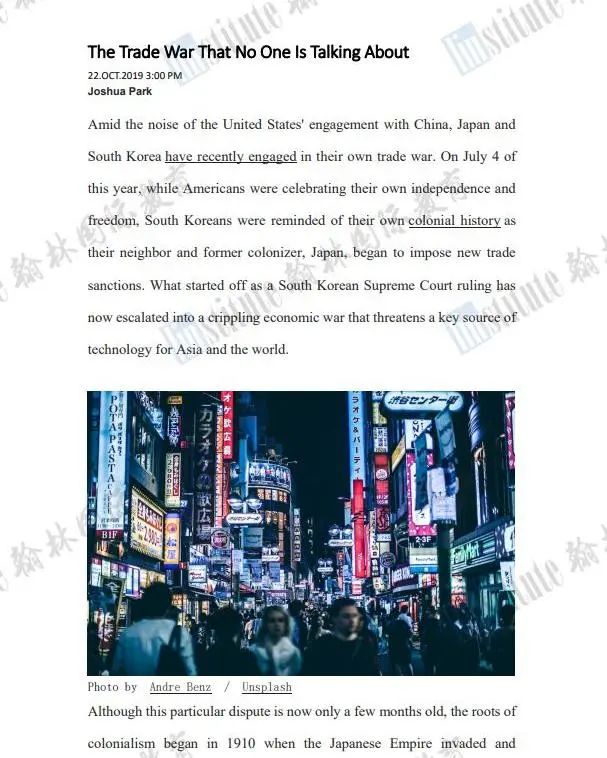
《哈佛国际评论》优秀范文
扫码领取

我要领取!
爱好写作的同学们看过来!除了接下来的HIR秋季赛之外,小林还为你整理了这些文科写作竞赛!
高含金量文科赛事List
🏆 John Locke 写作比赛
🏆《New York Times》纽约时报写作
🏆哈佛国际经济学论文大赛
🏆 IEA 全球经济学论文比赛
🏆马歇尔学会经济论文比赛
🏆RES青年经济学家写作
🏆《The Concord Review》历史论文
🏆国际DNA Day论文比赛
🏆Scholastic Art & Writing Awards
如果你也想提升自身的文学写作能力
翰林特别开设了文科写作辅导课程
一对一定制化辅导
给予学生研究和写作上的专业建议
协助学生打磨和撰写高质量的论文
更多信息可扫描上方二维码 咨询顾问
翰林文科导师阵容(部分)

翰林白老师
霍特国际商学院旧金山分校社会企业创业硕士
●西班牙巴塞罗那自治大学(美国德州农工梅斯商学院海外交换)企业管理学士
●美国大学理事会、剑桥国际教育、IBO三认证老师
●IEO、NEC、FBLA认证教练
●国家中级经济师
●学员战绩斐然,曾多次带出IEO全国第一,NEC全国第一,NEC全球单项第一
●2022年 指导高中学生以第一作者身份发表ICEMGD国际经济学会议期刊,论文进入CPCI检索
●2023年执教Johnlocke经济学方向5名学员中4名入围(shortlisted)

翰林文科沈老师
悉尼大学文学士
墨尔本大学教育学院中学教育硕士
●澳大利亚维多利亚州人文学科(历史、政治、地理、经济、宗教和道德)注册教师。
●澳大利亚National History Challenge (澳洲版NHD)家历史大赛州级评委,熟悉国际文科竞赛考量维度。
● 2020年开始,连续数年执教数十名学生获得John Locke论文比赛中的Very High Commendation,Commondation等奖项,指导的心理学方向论文学生成功进入普林斯顿大学。

翰林彭老师
宾夕法尼亚大学教学和领导力硕士
●卫斯理大学跨学科教育学士
●本科期间同时辅修了环境学和心理学等课程,研究生期间学习内容涉及社会学和哲学
●曾在深圳私立国际学校任教10-12年级托福和英文演讲课程
●4位学生入围哈佛国际评论答辩环节,其中最好成绩为银奖
●3位学生入围2023年Johnlocke心理方向和低年级组的论文比赛
* 以上赛事主办方为海外机构,不与任何中国的大学、中学或小学升学加分活动挂钩,其成绩不会作为任何中国中小学升学或评优的依据,仅定位为针对中学生的课外兴趣活动和国际教学交流活动。










